Only on the margins of Strathbungo, but having grown up on the margins of an aircraft factory, I love a bit of aviation trivia. This is the story of the crash, the pilot, the flying school, his plane, and a meander into the beginnings of unpowered flight.
Thrilling Crash
On this day, 25 May, almost 100 years ago, East Pollokshields was witness to a “thrilling” plane crash .
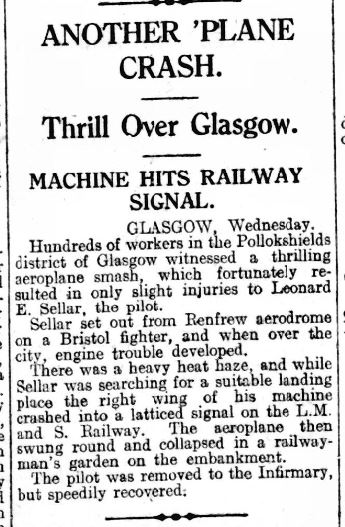
The news even reached Portsmouth. But they couldn’t get the pilot’s name right. Portsmouth Evening News, 25 May 1927. Credit: BNA
On 25 May 1927 Leonard Falla set off from Renfrew Aerodrome in his Bristol Type 89A Jupiter Advanced Trainer. He was flying over the city of Glasgow when his plane developed engine trouble. Searching for a suitable landing place, he eyed up the tracks north of Pollokshields East railway station, which were a lot wider then than now. However he caught his right wing on a large signal post, demolishing it, and spun round to crash on the embankment, apparently in a railwayman’s garden. He came to rest opposite the art nouveau Millar & Lang’s Printworks (now McCormick House) on Darnley Street. Excited onlookers were amazed to see the pilot escape with little more than an injury to his nose, and to his pride. He was taken to the infirmary but later released .
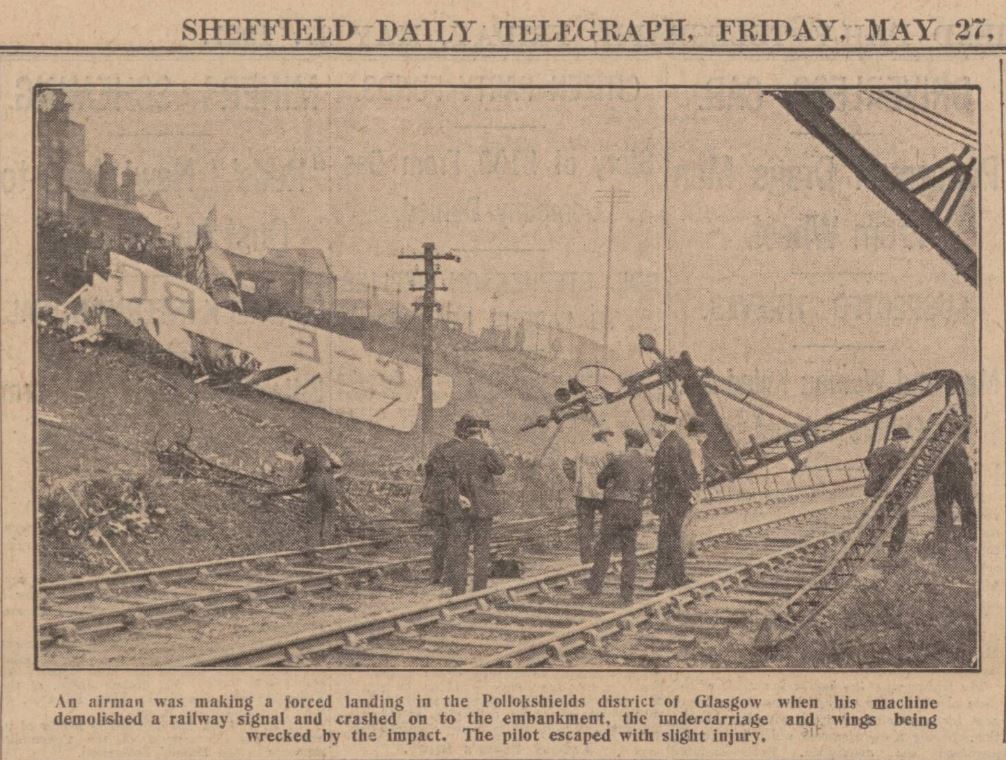
Note McCormick House in the background. There is a car parking bay on the embankment now. Sheffield Daily Telegraph 27 May 1927. Source: BNA
Flying-Officer Falla was attached to the Royal Air Force Reserve at the time. He was born in Kent in 1897 and signed up as a driver in the first world war. He joined the RAF Reserve in March 1924, and was in training when he had his accident.
Renfrew Reserve Flying School
The RAF’s Reserve Flying School at Renfrew was run under contract by William Beardmore & Co Ltd, the Clydebank-based engineering and shipbuilding firm. In the 1920s the company was exploring aviation, including building the world’s largest monoplane at the time, the Beardmore Inflexible . The flying school opened on 24 July 1924 but was fairly shortlived, being disbanded on 3 November 1928 .
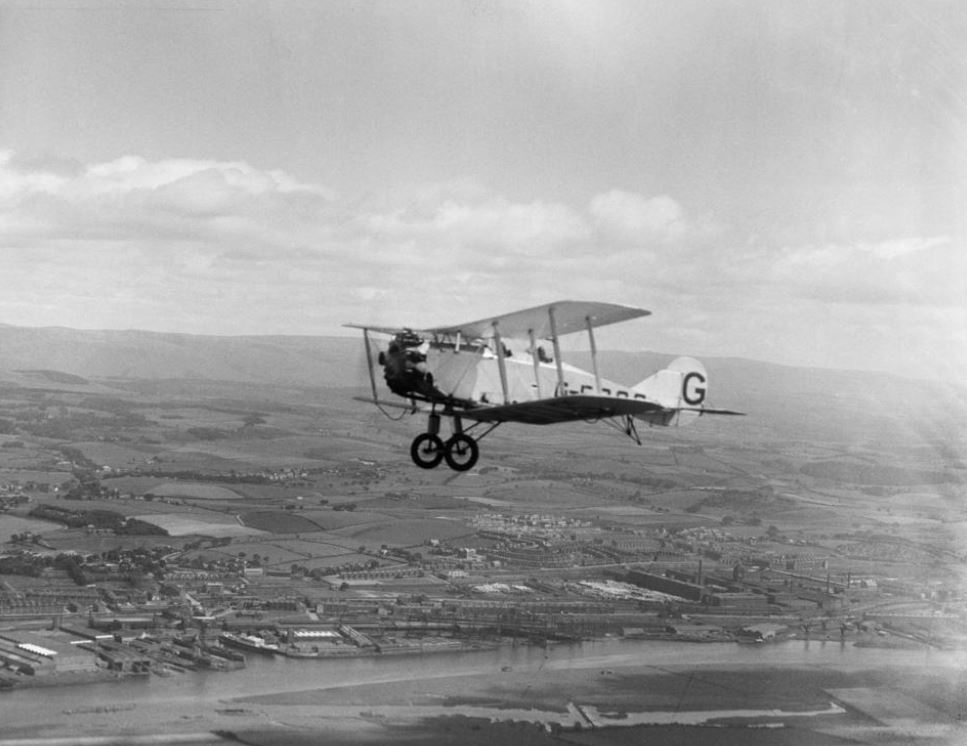
Beardmore Flying School Bristol Trainer G-EBQS over the Beardmore Works, Dalmuir, Clydebank. Now the site of the Golden Jubilee Hospital. Source: Aerofilms, Canmore SC 1259292
Bristol Jupiter Type 89
The school used six different Bristol 89 or 89A Advanced Trainers, which used Bristol’s successful Jupiter radial engine. They were registered as G-EBNZ, G-EBOA, G-EBOD, G-EBQS, G-EBSB and G-EBVR .
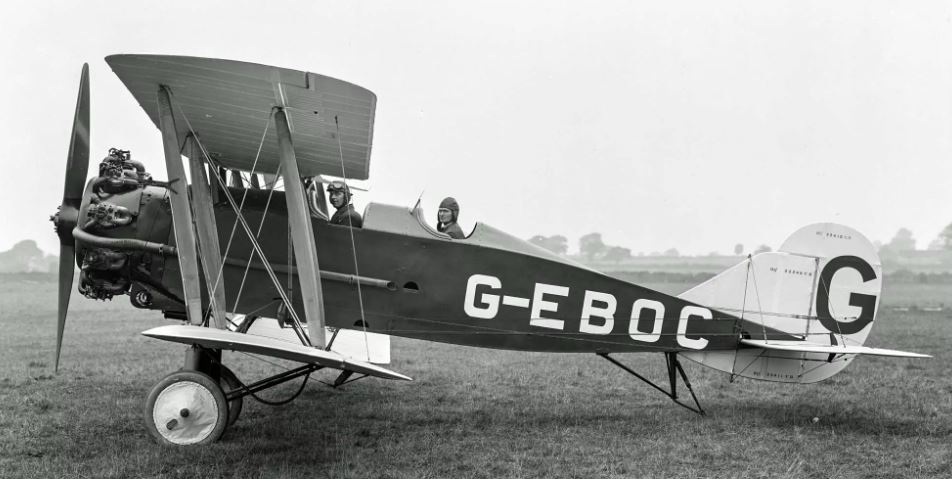
The first Bristol Type 89A variant, G-EBOC, stayed at Filton, Bristol. The second, G-EBOD, was Falla’s ill-fated plane. Source: BAE Systems
G-EBOA stalled, crashed and burned on take off in March 1927, killing its pilot, Flying Officer John Matthew Walker. Falla’s plane, G-EBOD, arrived from Bristol in April, but was damaged beyond repair in his accident six weeks later .
The school’s seventh and final aircraft, G-EBWN, was registered a few weeks after Falla’s crash; it was reassembled on site by Beardmores from parts of the two crashed aircraft . I’m not sure that was a plane I would have wished to have flown, but it survived until all Beardmore’s Bristol aircraft were scrapped in 1929.
Falla’s gliding career
Falla became a well-regarded pioneer of the new sport of gliding in the inter war years. He founded the Preston Gliding Club on 14 Oct 1930 and acted as its flying instructor, wishing to bring the joys of flying to the masses. He immediately acquired an RFD Dagling primary glider for the club, cost £55. This was a basic machine for gliding down gentle slopes, allowing a new pilot to experience flight controls in a (relatively) safe environment. It was not intended for long soaring flights. Falla, who by this time had 2,000 hours experience with powered flight, first flew the glider on 30 November, achieving 35 seconds in the air. In December they moved to Beacon Fell in the Forest of Bowland and Falla began training his fellow members in basic flight .
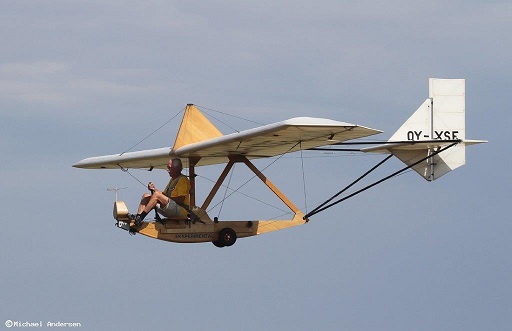
A restored Dagling glider (a later Slingsby T3 model). The name Dagling came from its original UK builder, Reginald Foster Dagnall, who built his first in 1930, and its German inspiration the Zogling (translation: Pupil). Source: Belgian Aviation Preservation Association/Michael Anderson
.
Not one to allow a single plane crash to suffice, Falla managed to land his Dagling glider upside down in strong winds on 7 April 1931.
In May 1931 he organised an event on the J Lyons & Co sponsored gliding tour. The Germans were the pioneers of gliding, partly due to restrictions on the building of powered aircraft post war, and Lyons invited the famous German glider pilot Hans Krause to demonstrate soaring flight around the UK in his Westpreussen “Lyons Tea Cloud Yacht” and his Falke gliders, while offering free Lyons tea to all spectators from their mobile tea van . Seven thousand spectators descended on Beacon Fell, only to be met with a dead calm all weekend.
Krause managed two 5 minute flights despite the lack of wind, though both ended in mishaps, the tail snapping off on the second landing. He then managed a better flight in the Falke. Not as bad as his demonstration flight in Yorkshire the following weekend when he span into the ground and destroyed the Cloud Yacht, though miraculously escaping unharmed. Meanwhile Falla managed a flight of 1 min 35 seconds in the RFD Dagling. More successful was the demonstration of the club’s new (old) Ford car. With a long cable, a drum attached to the rear wheel and the car jacked up, it was used to retrieve the gliders from the valley below after each flight!
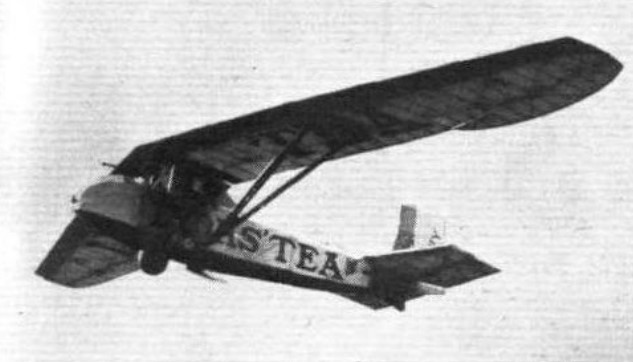
The Lyons Tea Falke glider flown by Herr Krause on tour in 1931. Source: Blackpool & Fylde Gliding Club
The club moved to car towing on a beach at Heysham, although Falla fainted on the beach when in May 1932 one of his pupils stalled and crashed and was killed instantly . Falla continued flying, managing up to 55 minutes in the Dagling.
The club also purchased and built a BAC VII two seater glider in July 1934. Falla then became interested in ultralight flying, and converted their BAC VII to the BAC Super Drone configuration, and registered it as G-AENZ. This had a Douglas Sprite 23hp engine fitted above the wing .
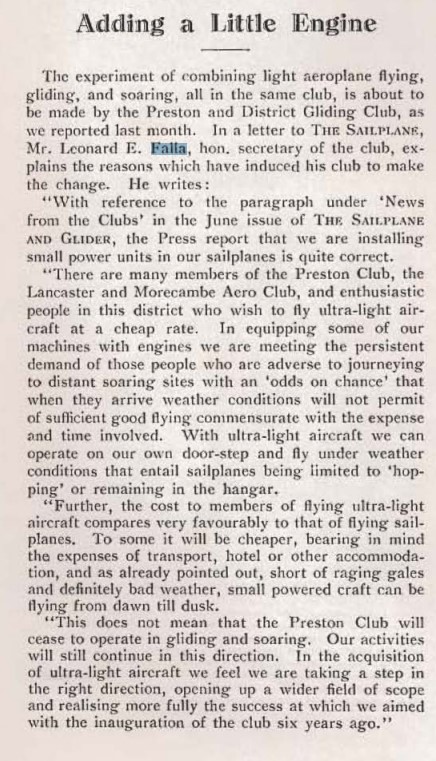
Adding a little engine. Sailplane & Glider 1936. Source: Lakes Gliding Club
This may not have been successful, as they later sued the supplier of the engine for a faulty crankshaft .

A BAC Drone, based on the BAC VII, with an engine mounted above the wing. Len Falla & Preston GC converted their own VII to a similar Super Drone. Source: Aviastar
Falla was still secretary in 1937 but no records of his gliding exist after that. He was called up again by the RAF in 1939, but relinquished his commission as a Flight Lieutenant on account of ill health in June 1941, possibly as he was suffering from TB. He died from a gunshot wound to the chest in September 1945 at Megdale, Broughton, Peebleshire, and was buried at Broughton. The circumstances of his death are unclear, but presumably self-inflicted. It also isn’t clear why he was in Scotland, given he lived with his wife in Lancashire. .
Renfrew Aerodrome
Renfrew aerodrome was created during the first world war on land requisitioned from Newmains Farm. It was the base for the 602 City of Glasgow Squadron before World War 2. After the war it was developed as Glasgow’s passenger airport, and a striking new terminal building was opened in 1954 .
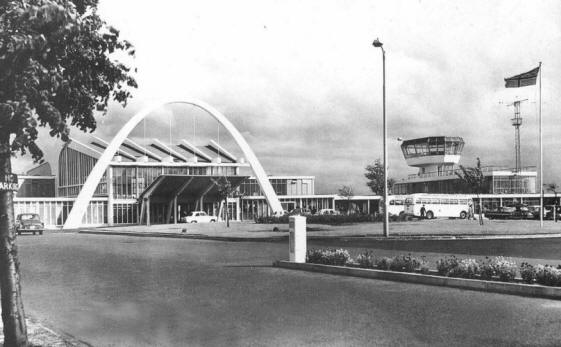
Renfrew Airport Terminal, 1954 by William Kininmonth. Source: Unknown
However it only lasted 12 years, when Glasgow Airport was moved less than two miles to Abbotsinch, its current home. The site of the terminal building is now Tesco Newmains, while the straight stretch of M8 west of Hillington J26, follows the line of the old runway.
Acknowledgements
Thanks to SGHET, who first spotted this story a few years back. If you like Glasgow aviation stories, read Andy Arthur’s thread on the slightly bonkers tale of the Beardmore Inflexible, or even better Weirs of Cathcart’s involvment in the development of the autogyro and helicopter.
Additions and corrections welcome.
References
{3557955:SDHBPKLF};{3557955:SDHBPKLF},{3557955:TT7M8XPG};{3557955:MSWDHALD};{3557955:K5T5ZZEF};{3557955:QW8Z6UVV},{3557955:5HDDTEVU};{3557955:VIR2MDEJ},{3557955:JA8QBZY5};{3557955:QW8Z6UVV};{3557955:PZZS65KE};{3557955:PBVL7TFN};{3557955:PI5K2JYM};{3557955:IRHZL6KP};{3557955:5K45PD9B};{3557955:PZZS65KE};{3557955:ZAR99S5C},{3557955:YGYHNETZ},{3557955:8WAXJWC6};{3557955:AEEX7UZ6}
vancouver
asc
0
4129
%7B%22status%22%3A%22success%22%2C%22updateneeded%22%3Afalse%2C%22instance%22%3A%22zotpress-b7f66ad64b5268539114fcf94ee405e3%22%2C%22meta%22%3A%7B%22request_last%22%3A0%2C%22request_next%22%3A0%2C%22used_cache%22%3Atrue%7D%2C%22data%22%3A%5B%7B%22key%22%3A%225K45PD9B%22%2C%22library%22%3A%7B%22id%22%3A3557955%7D%2C%22meta%22%3A%7B%22numChildren%22%3A1%7D%2C%22bib%22%3A%22%3Cdiv%20class%3D%5C%22csl-bib-body%5C%22%20style%3D%5C%22line-height%3A%201.35%3B%20%5C%22%3E%5Cn%20%20%3Cdiv%20class%3D%5C%22csl-entry%5C%22%20style%3D%5C%22clear%3A%20left%3B%20%5C%22%3E%5Cn%20%20%20%20%3Cdiv%20class%3D%5C%22csl-left-margin%5C%22%20style%3D%5C%22float%3A%20left%3B%20padding-right%3A%200.5em%3B%20text-align%3A%20right%3B%20width%3A%201em%3B%5C%22%3E1.%3C%5C%2Fdiv%3E%3Cdiv%20class%3D%5C%22csl-right-inline%5C%22%20style%3D%5C%22margin%3A%200%20.4em%200%201.5em%3B%5C%22%3EB.A.C.VII%2C%20Planette%20and%20Drone%20%5BInternet%5D.%20%5Bcited%202023%20May%2024%5D.%20Available%20from%3A%20%3Ca%20href%3D%27http%3A%5C%2F%5C%2Fwww.britishaviation-ptp.com%5C%2Fb%5C%2Fba_7.html%27%3Ehttp%3A%5C%2F%5C%2Fwww.britishaviation-ptp.com%5C%2Fb%5C%2Fba_7.html%3C%5C%2Fa%3E%3C%5C%2Fdiv%3E%5Cn%20%20%3C%5C%2Fdiv%3E%5Cn%3C%5C%2Fdiv%3E%22%2C%22data%22%3A%7B%22itemType%22%3A%22webpage%22%2C%22title%22%3A%22B.A.C.VII%2C%20Planette%20and%20Drone%22%2C%22creators%22%3A%5B%5D%2C%22abstractNote%22%3A%22%22%2C%22date%22%3A%22%22%2C%22url%22%3A%22http%3A%5C%2F%5C%2Fwww.britishaviation-ptp.com%5C%2Fb%5C%2Fba_7.html%22%2C%22language%22%3A%22%22%2C%22collections%22%3A%5B%22CAR6MXPM%22%5D%2C%22dateModified%22%3A%222023-05-24T17%3A34%3A53Z%22%7D%7D%2C%7B%22key%22%3A%22IRHZL6KP%22%2C%22library%22%3A%7B%22id%22%3A3557955%7D%2C%22meta%22%3A%7B%22parsedDate%22%3A%221932-05-16%22%2C%22numChildren%22%3A1%7D%2C%22bib%22%3A%22%3Cdiv%20class%3D%5C%22csl-bib-body%5C%22%20style%3D%5C%22line-height%3A%201.35%3B%20%5C%22%3E%5Cn%20%20%3Cdiv%20class%3D%5C%22csl-entry%5C%22%20style%3D%5C%22clear%3A%20left%3B%20%5C%22%3E%5Cn%20%20%20%20%3Cdiv%20class%3D%5C%22csl-left-margin%5C%22%20style%3D%5C%22float%3A%20left%3B%20padding-right%3A%200.5em%3B%20text-align%3A%20right%3B%20width%3A%201em%3B%5C%22%3E1.%3C%5C%2Fdiv%3E%3Cdiv%20class%3D%5C%22csl-right-inline%5C%22%20style%3D%5C%22margin%3A%200%20.4em%200%201.5em%3B%5C%22%3EGlider%20Crash%20Death.%20Yorkshire%20Post%20and%20Leeds%20Intelligencer%20%5BInternet%5D.%201932%20May%2016%20%5Bcited%202023%20May%2024%5D%3B%20Available%20from%3A%20%3Ca%20href%3D%27https%3A%5C%2F%5C%2Fwww.britishnewspaperarchive.co.uk%5C%2Fviewer%5C%2Fbl%5C%2F0000687%5C%2F19320516%5C%2F183%5C%2F0009%27%3Ehttps%3A%5C%2F%5C%2Fwww.britishnewspaperarchive.co.uk%5C%2Fviewer%5C%2Fbl%5C%2F0000687%5C%2F19320516%5C%2F183%5C%2F0009%3C%5C%2Fa%3E%3C%5C%2Fdiv%3E%5Cn%20%20%3C%5C%2Fdiv%3E%5Cn%3C%5C%2Fdiv%3E%22%2C%22data%22%3A%7B%22itemType%22%3A%22newspaperArticle%22%2C%22title%22%3A%22Glider%20Crash%20Death%22%2C%22creators%22%3A%5B%5D%2C%22abstractNote%22%3A%22%22%2C%22date%22%3A%2216%20May%201932%22%2C%22section%22%3A%22%22%2C%22language%22%3A%22%22%2C%22ISSN%22%3A%22%22%2C%22url%22%3A%22https%3A%5C%2F%5C%2Fwww.britishnewspaperarchive.co.uk%5C%2Fviewer%5C%2Fbl%5C%2F0000687%5C%2F19320516%5C%2F183%5C%2F0009%22%2C%22collections%22%3A%5B%22CAR6MXPM%22%5D%2C%22dateModified%22%3A%222023-05-24T17%3A25%3A38Z%22%7D%7D%2C%7B%22key%22%3A%22PZZS65KE%22%2C%22library%22%3A%7B%22id%22%3A3557955%7D%2C%22meta%22%3A%7B%22numChildren%22%3A1%7D%2C%22bib%22%3A%22%3Cdiv%20class%3D%5C%22csl-bib-body%5C%22%20style%3D%5C%22line-height%3A%201.35%3B%20%5C%22%3E%5Cn%20%20%3Cdiv%20class%3D%5C%22csl-entry%5C%22%20style%3D%5C%22clear%3A%20left%3B%20%5C%22%3E%5Cn%20%20%20%20%3Cdiv%20class%3D%5C%22csl-left-margin%5C%22%20style%3D%5C%22float%3A%20left%3B%20padding-right%3A%200.5em%3B%20text-align%3A%20right%3B%20width%3A%201em%3B%5C%22%3E1.%3C%5C%2Fdiv%3E%3Cdiv%20class%3D%5C%22csl-right-inline%5C%22%20style%3D%5C%22margin%3A%200%20.4em%200%201.5em%3B%5C%22%3EBlackpool%20%26amp%3B%20Fylde%20Gliding%20Clubs%20%5BInternet%5D.%20%5Bcited%202023%20May%2024%5D.%20Blackpool%20%26amp%3B%20Fiddlers%3A%20The%20Curious%20History%20of%20Three%20Blackpool%20and%20Fylde%20Gliding%20Clubs.%20Available%20from%3A%20%3Ca%20href%3D%27https%3A%5C%2F%5C%2Fwww.bfgc.co.uk%5C%2FBFGC%2520History.pdf%27%3Ehttps%3A%5C%2F%5C%2Fwww.bfgc.co.uk%5C%2FBFGC%2520History.pdf%3C%5C%2Fa%3E%3C%5C%2Fdiv%3E%5Cn%20%20%3C%5C%2Fdiv%3E%5Cn%3C%5C%2Fdiv%3E%22%2C%22data%22%3A%7B%22itemType%22%3A%22webpage%22%2C%22title%22%3A%22Blackpool%20%26%20Fiddlers%3A%20The%20Curious%20History%20of%20Three%20Blackpool%20and%20Fylde%20Gliding%20Clubs.%22%2C%22creators%22%3A%5B%5D%2C%22abstractNote%22%3A%22%22%2C%22date%22%3A%22%22%2C%22url%22%3A%22https%3A%5C%2F%5C%2Fwww.bfgc.co.uk%5C%2FBFGC%2520History.pdf%22%2C%22language%22%3A%22%22%2C%22collections%22%3A%5B%22CAR6MXPM%22%5D%2C%22dateModified%22%3A%222023-05-24T16%3A50%3A57Z%22%7D%7D%2C%7B%22key%22%3A%22PI5K2JYM%22%2C%22library%22%3A%7B%22id%22%3A3557955%7D%2C%22meta%22%3A%7B%22parsedDate%22%3A%221931-05-22%22%2C%22numChildren%22%3A1%7D%2C%22bib%22%3A%22%3Cdiv%20class%3D%5C%22csl-bib-body%5C%22%20style%3D%5C%22line-height%3A%201.35%3B%20%5C%22%3E%5Cn%20%20%3Cdiv%20class%3D%5C%22csl-entry%5C%22%20style%3D%5C%22clear%3A%20left%3B%20%5C%22%3E%5Cn%20%20%20%20%3Cdiv%20class%3D%5C%22csl-left-margin%5C%22%20style%3D%5C%22float%3A%20left%3B%20padding-right%3A%200.5em%3B%20text-align%3A%20right%3B%20width%3A%201em%3B%5C%22%3E1.%3C%5C%2Fdiv%3E%3Cdiv%20class%3D%5C%22csl-right-inline%5C%22%20style%3D%5C%22margin%3A%200%20.4em%200%201.5em%3B%5C%22%3EThe%20Preston%20%26amp%3B%20District%20Glider%20Club.%20Sailplane%20%26amp%3B%20Glider%20%5BInternet%5D.%201931%20May%2022%20%5Bcited%202023%20May%2024%5D%3B1%2837%29.%20Available%20from%3A%20%3Ca%20href%3D%27https%3A%5C%2F%5C%2Fwww.lakesgc.co.uk%5C%2Fmainwebpages%5C%2FSailplane%2520%26%2520Glider%25201930%2520-%25201955%5C%2FVolume%25201%2520No.%252037%2520May%252022%25201931.pdf%27%3Ehttps%3A%5C%2F%5C%2Fwww.lakesgc.co.uk%5C%2Fmainwebpages%5C%2FSailplane%2520%26%2520Glider%25201930%2520-%25201955%5C%2FVolume%25201%2520No.%252037%2520May%252022%25201931.pdf%3C%5C%2Fa%3E%3C%5C%2Fdiv%3E%5Cn%20%20%3C%5C%2Fdiv%3E%5Cn%3C%5C%2Fdiv%3E%22%2C%22data%22%3A%7B%22itemType%22%3A%22magazineArticle%22%2C%22title%22%3A%22The%20Preston%20%26%20District%20Glider%20Club%22%2C%22creators%22%3A%5B%5D%2C%22abstractNote%22%3A%22%22%2C%22date%22%3A%2222%20May%201931%22%2C%22language%22%3A%22%22%2C%22ISSN%22%3A%22%22%2C%22url%22%3A%22https%3A%5C%2F%5C%2Fwww.lakesgc.co.uk%5C%2Fmainwebpages%5C%2FSailplane%2520%26%2520Glider%25201930%2520-%25201955%5C%2FVolume%25201%2520No.%252037%2520May%252022%25201931.pdf%22%2C%22collections%22%3A%5B%22CAR6MXPM%22%5D%2C%22dateModified%22%3A%222023-05-24T16%3A34%3A42Z%22%7D%7D%2C%7B%22key%22%3A%22PBVL7TFN%22%2C%22library%22%3A%7B%22id%22%3A3557955%7D%2C%22meta%22%3A%7B%22parsedDate%22%3A%221931%22%2C%22numChildren%22%3A1%7D%2C%22bib%22%3A%22%3Cdiv%20class%3D%5C%22csl-bib-body%5C%22%20style%3D%5C%22line-height%3A%201.35%3B%20%5C%22%3E%5Cn%20%20%3Cdiv%20class%3D%5C%22csl-entry%5C%22%20style%3D%5C%22clear%3A%20left%3B%20%5C%22%3E%5Cn%20%20%20%20%3Cdiv%20class%3D%5C%22csl-left-margin%5C%22%20style%3D%5C%22float%3A%20left%3B%20padding-right%3A%200.5em%3B%20text-align%3A%20right%3B%20width%3A%201em%3B%5C%22%3E1.%3C%5C%2Fdiv%3E%3Cdiv%20class%3D%5C%22csl-right-inline%5C%22%20style%3D%5C%22margin%3A%200%20.4em%200%201.5em%3B%5C%22%3ESouvenir%20Programme.%20Sailplane%20%26amp%3B%20Glider%20%5BInternet%5D.%201931%20%5Bcited%202023%20May%2024%5D%3B%20Available%20from%3A%20%3Ca%20href%3D%27https%3A%5C%2F%5C%2Fs3-eu-west-1.amazonaws.com%5C%2Fbga-sg-archive%5C%2FAdditional%2Bmaterial%2B-%2B6%2Bfiles%2B28MB%5C%2FSouvenir%2BProgramme%2BSailplane%2B%2526%2BGlider%2Bapprox%2B1931.pdf%27%3Ehttps%3A%5C%2F%5C%2Fs3-eu-west-1.amazonaws.com%5C%2Fbga-sg-archive%5C%2FAdditional%2Bmaterial%2B-%2B6%2Bfiles%2B28MB%5C%2FSouvenir%2BProgramme%2BSailplane%2B%2526%2BGlider%2Bapprox%2B1931.pdf%3C%5C%2Fa%3E%3C%5C%2Fdiv%3E%5Cn%20%20%3C%5C%2Fdiv%3E%5Cn%3C%5C%2Fdiv%3E%22%2C%22data%22%3A%7B%22itemType%22%3A%22magazineArticle%22%2C%22title%22%3A%22Souvenir%20Programme%22%2C%22creators%22%3A%5B%5D%2C%22abstractNote%22%3A%22%22%2C%22date%22%3A%221931%22%2C%22language%22%3A%22%22%2C%22ISSN%22%3A%22%22%2C%22url%22%3A%22https%3A%5C%2F%5C%2Fs3-eu-west-1.amazonaws.com%5C%2Fbga-sg-archive%5C%2FAdditional%2Bmaterial%2B-%2B6%2Bfiles%2B28MB%5C%2FSouvenir%2BProgramme%2BSailplane%2B%2526%2BGlider%2Bapprox%2B1931.pdf%22%2C%22collections%22%3A%5B%22CAR6MXPM%22%5D%2C%22dateModified%22%3A%222023-05-24T16%3A32%3A02Z%22%7D%7D%2C%7B%22key%22%3A%228WAXJWC6%22%2C%22library%22%3A%7B%22id%22%3A3557955%7D%2C%22meta%22%3A%7B%22numChildren%22%3A1%7D%2C%22bib%22%3A%22%3Cdiv%20class%3D%5C%22csl-bib-body%5C%22%20style%3D%5C%22line-height%3A%201.35%3B%20%5C%22%3E%5Cn%20%20%3Cdiv%20class%3D%5C%22csl-entry%5C%22%20style%3D%5C%22clear%3A%20left%3B%20%5C%22%3E%5Cn%20%20%20%20%3Cdiv%20class%3D%5C%22csl-left-margin%5C%22%20style%3D%5C%22float%3A%20left%3B%20padding-right%3A%200.5em%3B%20text-align%3A%20right%3B%20width%3A%201em%3B%5C%22%3E1.%3C%5C%2Fdiv%3E%3Cdiv%20class%3D%5C%22csl-right-inline%5C%22%20style%3D%5C%22margin%3A%200%20.4em%200%201.5em%3B%5C%22%3E1945%20FALLA%2C%20LEONARD%20ERNEST%20%28Statutory%20registers%20Corrected%20Entries%20758%5C%2F%2000%20001%2036%29%20%28RCE%29%20%7C%20ScotlandsPeople%20%5BInternet%5D.%20%5Bcited%202023%20May%2022%5D.%20Available%20from%3A%20%3Ca%20href%3D%27https%3A%5C%2F%5C%2Fwww.scotlandspeople.gov.uk%5C%2Fimage-viewer%5C%2Fstat_rce%5C%2Fstat_rce-375463_5605150_D%3Fsearch_token%3D832294215646b78e819c30%27%3Ehttps%3A%5C%2F%5C%2Fwww.scotlandspeople.gov.uk%5C%2Fimage-viewer%5C%2Fstat_rce%5C%2Fstat_rce-375463_5605150_D%3Fsearch_token%3D832294215646b78e819c30%3C%5C%2Fa%3E%3C%5C%2Fdiv%3E%5Cn%20%20%3C%5C%2Fdiv%3E%5Cn%3C%5C%2Fdiv%3E%22%2C%22data%22%3A%7B%22itemType%22%3A%22webpage%22%2C%22title%22%3A%221945%20FALLA%2C%20LEONARD%20ERNEST%20%28Statutory%20registers%20Corrected%20Entries%20758%5C%2F%2000%20001%2036%29%20%28RCE%29%20%7C%20ScotlandsPeople%22%2C%22creators%22%3A%5B%5D%2C%22abstractNote%22%3A%22%22%2C%22date%22%3A%22%22%2C%22url%22%3A%22https%3A%5C%2F%5C%2Fwww.scotlandspeople.gov.uk%5C%2Fimage-viewer%5C%2Fstat_rce%5C%2Fstat_rce-375463_5605150_D%3Fsearch_token%3D832294215646b78e819c30%22%2C%22language%22%3A%22%22%2C%22collections%22%3A%5B%22CAR6MXPM%22%5D%2C%22dateModified%22%3A%222023-05-22T14%3A22%3A48Z%22%7D%7D%2C%7B%22key%22%3A%22MSWDHALD%22%2C%22library%22%3A%7B%22id%22%3A3557955%7D%2C%22meta%22%3A%7B%22numChildren%22%3A0%7D%2C%22bib%22%3A%22%3Cdiv%20class%3D%5C%22csl-bib-body%5C%22%20style%3D%5C%22line-height%3A%201.35%3B%20%5C%22%3E%5Cn%20%20%3Cdiv%20class%3D%5C%22csl-entry%5C%22%20style%3D%5C%22clear%3A%20left%3B%20%5C%22%3E%5Cn%20%20%20%20%3Cdiv%20class%3D%5C%22csl-left-margin%5C%22%20style%3D%5C%22float%3A%20left%3B%20padding-right%3A%200.5em%3B%20text-align%3A%20right%3B%20width%3A%201em%3B%5C%22%3E1.%3C%5C%2Fdiv%3E%3Cdiv%20class%3D%5C%22csl-right-inline%5C%22%20style%3D%5C%22margin%3A%200%20.4em%200%201.5em%3B%5C%22%3EThe%20thread%20about%20the%20brief%20life%20of%20the%20Dalmuir%20aero%20industry%3B%20when%20Clyde%20shipbuilders%20constructed%20the%20largest%20aircraft%20in%20the%20world%20%26%23x2013%3B%20Threadinburgh%20%5BInternet%5D.%20%5Bcited%202023%20May%2022%5D.%20Available%20from%3A%20%3Ca%20href%3D%27https%3A%5C%2F%5C%2Fthreadinburgh.scot%5C%2F2022%5C%2F11%5C%2F06%5C%2Fthe-thread-about-the-brief-life-of-the-dalmuir-aero-industry-when-clyde-shipbuilders-constructed-the-largest-aircraft-in-the-world%5C%2F%27%3Ehttps%3A%5C%2F%5C%2Fthreadinburgh.scot%5C%2F2022%5C%2F11%5C%2F06%5C%2Fthe-thread-about-the-brief-life-of-the-dalmuir-aero-industry-when-clyde-shipbuilders-constructed-the-largest-aircraft-in-the-world%5C%2F%3C%5C%2Fa%3E%3C%5C%2Fdiv%3E%5Cn%20%20%3C%5C%2Fdiv%3E%5Cn%3C%5C%2Fdiv%3E%22%2C%22data%22%3A%7B%22itemType%22%3A%22webpage%22%2C%22title%22%3A%22The%20thread%20about%20the%20brief%20life%20of%20the%20Dalmuir%20aero%20industry%3B%20when%20Clyde%20shipbuilders%20constructed%20the%20largest%20aircraft%20in%20the%20world%20%5Cu2013%20Threadinburgh%22%2C%22creators%22%3A%5B%5D%2C%22abstractNote%22%3A%22%22%2C%22date%22%3A%22%22%2C%22url%22%3A%22https%3A%5C%2F%5C%2Fthreadinburgh.scot%5C%2F2022%5C%2F11%5C%2F06%5C%2Fthe-thread-about-the-brief-life-of-the-dalmuir-aero-industry-when-clyde-shipbuilders-constructed-the-largest-aircraft-in-the-world%5C%2F%22%2C%22language%22%3A%22%22%2C%22collections%22%3A%5B%22CAR6MXPM%22%5D%2C%22dateModified%22%3A%222023-05-22T12%3A23%3A32Z%22%7D%7D%2C%7B%22key%22%3A%22ZAR99S5C%22%2C%22library%22%3A%7B%22id%22%3A3557955%7D%2C%22meta%22%3A%7B%22parsedDate%22%3A%221945-09-17%22%2C%22numChildren%22%3A1%7D%2C%22bib%22%3A%22%3Cdiv%20class%3D%5C%22csl-bib-body%5C%22%20style%3D%5C%22line-height%3A%201.35%3B%20%5C%22%3E%5Cn%20%20%3Cdiv%20class%3D%5C%22csl-entry%5C%22%20style%3D%5C%22clear%3A%20left%3B%20%5C%22%3E%5Cn%20%20%20%20%3Cdiv%20class%3D%5C%22csl-left-margin%5C%22%20style%3D%5C%22float%3A%20left%3B%20padding-right%3A%200.5em%3B%20text-align%3A%20right%3B%20width%3A%201em%3B%5C%22%3E1.%3C%5C%2Fdiv%3E%3Cdiv%20class%3D%5C%22csl-right-inline%5C%22%20style%3D%5C%22margin%3A%200%20.4em%200%201.5em%3B%5C%22%3EPreston%20Gliding%20Club%20Founder%20Dead.%20Lancashire%20Evening%20Post%20%5BInternet%5D.%201945%20Sep%2017%20%5Bcited%202023%20May%2022%5D%3B%20Available%20from%3A%20%3Ca%20href%3D%27https%3A%5C%2F%5C%2Fwww.britishnewspaperarchive.co.uk%5C%2Fviewer%5C%2Fbl%5C%2F0000711%5C%2F19450917%5C%2F011%5C%2F0001%27%3Ehttps%3A%5C%2F%5C%2Fwww.britishnewspaperarchive.co.uk%5C%2Fviewer%5C%2Fbl%5C%2F0000711%5C%2F19450917%5C%2F011%5C%2F0001%3C%5C%2Fa%3E%3C%5C%2Fdiv%3E%5Cn%20%20%3C%5C%2Fdiv%3E%5Cn%3C%5C%2Fdiv%3E%22%2C%22data%22%3A%7B%22itemType%22%3A%22newspaperArticle%22%2C%22title%22%3A%22Preston%20Gliding%20Club%20Founder%20Dead%22%2C%22creators%22%3A%5B%5D%2C%22abstractNote%22%3A%22%22%2C%22date%22%3A%2217%20Sep%201945%22%2C%22section%22%3A%22%22%2C%22language%22%3A%22%22%2C%22ISSN%22%3A%22%22%2C%22url%22%3A%22https%3A%5C%2F%5C%2Fwww.britishnewspaperarchive.co.uk%5C%2Fviewer%5C%2Fbl%5C%2F0000711%5C%2F19450917%5C%2F011%5C%2F0001%22%2C%22collections%22%3A%5B%22CAR6MXPM%22%5D%2C%22dateModified%22%3A%222023-05-22T11%3A05%3A14Z%22%7D%7D%2C%7B%22key%22%3A%22YGYHNETZ%22%2C%22library%22%3A%7B%22id%22%3A3557955%7D%2C%22meta%22%3A%7B%22numChildren%22%3A1%7D%2C%22bib%22%3A%22%3Cdiv%20class%3D%5C%22csl-bib-body%5C%22%20style%3D%5C%22line-height%3A%201.35%3B%20%5C%22%3E%5Cn%20%20%3Cdiv%20class%3D%5C%22csl-entry%5C%22%20style%3D%5C%22clear%3A%20left%3B%20%5C%22%3E%5Cn%20%20%20%20%3Cdiv%20class%3D%5C%22csl-left-margin%5C%22%20style%3D%5C%22float%3A%20left%3B%20padding-right%3A%200.5em%3B%20text-align%3A%20right%3B%20width%3A%201em%3B%5C%22%3E1.%3C%5C%2Fdiv%3E%3Cdiv%20class%3D%5C%22csl-right-inline%5C%22%20style%3D%5C%22margin%3A%200%20.4em%200%201.5em%3B%5C%22%3ERAFCommands%20%5BInternet%5D.%20%5Bcited%202023%20May%2022%5D.%20Flight%20Lieutenant%20L%20E%20FALLA%20%2870210%29%2C%20Royal%20Air%20Force%20%28RAFO%29%29%20%5BRoyal%20Air%20Force%20WW2%20Casualty%20%5D.%20Available%20from%3A%20%3Ca%20href%3D%27http%3A%5C%2F%5C%2Fwww.rafcommands.com%5C%2Fdatabase%5C%2Fwardead%5C%2Fdetails.php%3Fqnum%3D70210%26qname%3DFALLA%26srname%3D%27%3Ehttp%3A%5C%2F%5C%2Fwww.rafcommands.com%5C%2Fdatabase%5C%2Fwardead%5C%2Fdetails.php%3Fqnum%3D70210%26qname%3DFALLA%26srname%3D%3C%5C%2Fa%3E%3C%5C%2Fdiv%3E%5Cn%20%20%3C%5C%2Fdiv%3E%5Cn%3C%5C%2Fdiv%3E%22%2C%22data%22%3A%7B%22itemType%22%3A%22webpage%22%2C%22title%22%3A%22Flight%20Lieutenant%20L%20E%20FALLA%20%2870210%29%2C%20Royal%20Air%20Force%20%28RAFO%29%29%20%5BRoyal%20Air%20Force%20WW2%20Casualty%20%5D%22%2C%22creators%22%3A%5B%5D%2C%22abstractNote%22%3A%22This%20is%20the%20individual%20page%20for%20%20Casualty%20%20Flight%20Lieutenant%20L%20E%20FALLA%20%2870210%29%2C%20Royal%20Air%20Force%20%28RAFO%29%20of%20the%20Royal%20Air%20Force.%20Died%20from%20a%20gun%20shot%20wound%20to%20his%20chest%20at%20Broughton%2C%20Peebles%20%28via%20Jon%20Heyworth%29.%20%20You%20may%20find%20some%20details%20of%20his%20career%2C%20loss%20details%2C%20maybe%20a%20photograph%2C%20and%20whatever%20mention%20of%20the%20person%20that%20occurs%20in%20the%20forum.%22%2C%22date%22%3A%22%22%2C%22url%22%3A%22http%3A%5C%2F%5C%2Fwww.rafcommands.com%5C%2Fdatabase%5C%2Fwardead%5C%2Fdetails.php%3Fqnum%3D70210%26qname%3DFALLA%26srname%3D%22%2C%22language%22%3A%22%22%2C%22collections%22%3A%5B%22CAR6MXPM%22%5D%2C%22dateModified%22%3A%222023-05-22T10%3A59%3A45Z%22%7D%7D%2C%7B%22key%22%3A%22AEEX7UZ6%22%2C%22library%22%3A%7B%22id%22%3A3557955%7D%2C%22meta%22%3A%7B%22numChildren%22%3A1%7D%2C%22bib%22%3A%22%3Cdiv%20class%3D%5C%22csl-bib-body%5C%22%20style%3D%5C%22line-height%3A%201.35%3B%20%5C%22%3E%5Cn%20%20%3Cdiv%20class%3D%5C%22csl-entry%5C%22%20style%3D%5C%22clear%3A%20left%3B%20%5C%22%3E%5Cn%20%20%20%20%3Cdiv%20class%3D%5C%22csl-left-margin%5C%22%20style%3D%5C%22float%3A%20left%3B%20padding-right%3A%200.5em%3B%20text-align%3A%20right%3B%20width%3A%201em%3B%5C%22%3E1.%3C%5C%2Fdiv%3E%3Cdiv%20class%3D%5C%22csl-right-inline%5C%22%20style%3D%5C%22margin%3A%200%20.4em%200%201.5em%3B%5C%22%3ESecret%20Scotland%20-%20Renfrew%20Airport%20%5BInternet%5D.%20%5Bcited%202023%20May%2019%5D.%20Available%20from%3A%20%3Ca%20href%3D%27https%3A%5C%2F%5C%2Fwww.secretscotland.org.uk%5C%2Findex.php%5C%2FSecrets%5C%2FRenfrewAirport%27%3Ehttps%3A%5C%2F%5C%2Fwww.secretscotland.org.uk%5C%2Findex.php%5C%2FSecrets%5C%2FRenfrewAirport%3C%5C%2Fa%3E%3C%5C%2Fdiv%3E%5Cn%20%20%3C%5C%2Fdiv%3E%5Cn%3C%5C%2Fdiv%3E%22%2C%22data%22%3A%7B%22itemType%22%3A%22webpage%22%2C%22title%22%3A%22Secret%20Scotland%20-%20Renfrew%20Airport%22%2C%22creators%22%3A%5B%5D%2C%22abstractNote%22%3A%22%22%2C%22date%22%3A%22%22%2C%22url%22%3A%22https%3A%5C%2F%5C%2Fwww.secretscotland.org.uk%5C%2Findex.php%5C%2FSecrets%5C%2FRenfrewAirport%22%2C%22language%22%3A%22%22%2C%22collections%22%3A%5B%22CAR6MXPM%22%5D%2C%22dateModified%22%3A%222023-05-19T19%3A04%3A53Z%22%7D%7D%2C%7B%22key%22%3A%22K5T5ZZEF%22%2C%22library%22%3A%7B%22id%22%3A3557955%7D%2C%22meta%22%3A%7B%22parsedDate%22%3A%222022-03-07%22%2C%22numChildren%22%3A1%7D%2C%22bib%22%3A%22%3Cdiv%20class%3D%5C%22csl-bib-body%5C%22%20style%3D%5C%22line-height%3A%201.35%3B%20%5C%22%3E%5Cn%20%20%3Cdiv%20class%3D%5C%22csl-entry%5C%22%20style%3D%5C%22clear%3A%20left%3B%20%5C%22%3E%5Cn%20%20%20%20%3Cdiv%20class%3D%5C%22csl-left-margin%5C%22%20style%3D%5C%22float%3A%20left%3B%20padding-right%3A%200.5em%3B%20text-align%3A%20right%3B%20width%3A%201em%3B%5C%22%3E1.%3C%5C%2Fdiv%3E%3Cdiv%20class%3D%5C%22csl-right-inline%5C%22%20style%3D%5C%22margin%3A%200%20.4em%200%201.5em%3B%5C%22%3EList%20of%20Reserve%20flying%20schools.%20In%3A%20Wikipedia%20%5BInternet%5D.%202022%20%5Bcited%202023%20May%2019%5D.%20Available%20from%3A%20%3Ca%20href%3D%27https%3A%5C%2F%5C%2Fen.wikipedia.org%5C%2Fw%5C%2Findex.php%3Ftitle%3DList_of_Reserve_flying_schools%26oldid%3D1075675219%27%3Ehttps%3A%5C%2F%5C%2Fen.wikipedia.org%5C%2Fw%5C%2Findex.php%3Ftitle%3DList_of_Reserve_flying_schools%26oldid%3D1075675219%3C%5C%2Fa%3E%3C%5C%2Fdiv%3E%5Cn%20%20%3C%5C%2Fdiv%3E%5Cn%3C%5C%2Fdiv%3E%22%2C%22data%22%3A%7B%22itemType%22%3A%22encyclopediaArticle%22%2C%22title%22%3A%22List%20of%20Reserve%20flying%20schools%22%2C%22creators%22%3A%5B%5D%2C%22abstractNote%22%3A%22This%20is%20a%20List%20of%20Reserve%20flying%20schools%20of%20the%20Royal%20Air%20Force%22%2C%22encyclopediaTitle%22%3A%22Wikipedia%22%2C%22date%22%3A%222022-03-07T02%3A37%3A39Z%22%2C%22ISBN%22%3A%22%22%2C%22url%22%3A%22https%3A%5C%2F%5C%2Fen.wikipedia.org%5C%2Fw%5C%2Findex.php%3Ftitle%3DList_of_Reserve_flying_schools%26oldid%3D1075675219%22%2C%22language%22%3A%22en%22%2C%22collections%22%3A%5B%22CAR6MXPM%22%5D%2C%22dateModified%22%3A%222023-05-19T18%3A27%3A30Z%22%7D%7D%2C%7B%22key%22%3A%22SDHBPKLF%22%2C%22library%22%3A%7B%22id%22%3A3557955%7D%2C%22meta%22%3A%7B%22parsedDate%22%3A%221927-05-25%22%2C%22numChildren%22%3A1%7D%2C%22bib%22%3A%22%3Cdiv%20class%3D%5C%22csl-bib-body%5C%22%20style%3D%5C%22line-height%3A%201.35%3B%20%5C%22%3E%5Cn%20%20%3Cdiv%20class%3D%5C%22csl-entry%5C%22%20style%3D%5C%22clear%3A%20left%3B%20%5C%22%3E%5Cn%20%20%20%20%3Cdiv%20class%3D%5C%22csl-left-margin%5C%22%20style%3D%5C%22float%3A%20left%3B%20padding-right%3A%200.5em%3B%20text-align%3A%20right%3B%20width%3A%201em%3B%5C%22%3E1.%3C%5C%2Fdiv%3E%3Cdiv%20class%3D%5C%22csl-right-inline%5C%22%20style%3D%5C%22margin%3A%200%20.4em%200%201.5em%3B%5C%22%3EPlane%20Crash%20Thrill.%20Halifax%20Evening%20Courier%20%5BInternet%5D.%201927%20May%2025%20%5Bcited%202023%20May%2019%5D%3B%20Available%20from%3A%20%3Ca%20href%3D%27https%3A%5C%2F%5C%2Fwww.britishnewspaperarchive.co.uk%5C%2Fviewer%5C%2Fbl%5C%2F0003295%5C%2F19270525%5C%2F107%5C%2F0005%27%3Ehttps%3A%5C%2F%5C%2Fwww.britishnewspaperarchive.co.uk%5C%2Fviewer%5C%2Fbl%5C%2F0003295%5C%2F19270525%5C%2F107%5C%2F0005%3C%5C%2Fa%3E%3C%5C%2Fdiv%3E%5Cn%20%20%3C%5C%2Fdiv%3E%5Cn%3C%5C%2Fdiv%3E%22%2C%22data%22%3A%7B%22itemType%22%3A%22newspaperArticle%22%2C%22title%22%3A%22Plane%20Crash%20Thrill%22%2C%22creators%22%3A%5B%5D%2C%22abstractNote%22%3A%22%22%2C%22date%22%3A%2225%20May%201927%22%2C%22section%22%3A%22%22%2C%22language%22%3A%22%22%2C%22ISSN%22%3A%22%22%2C%22url%22%3A%22https%3A%5C%2F%5C%2Fwww.britishnewspaperarchive.co.uk%5C%2Fviewer%5C%2Fbl%5C%2F0003295%5C%2F19270525%5C%2F107%5C%2F0005%22%2C%22collections%22%3A%5B%22CAR6MXPM%22%5D%2C%22dateModified%22%3A%222023-05-19T17%3A59%3A39Z%22%7D%7D%2C%7B%22key%22%3A%22TT7M8XPG%22%2C%22library%22%3A%7B%22id%22%3A3557955%7D%2C%22meta%22%3A%7B%22parsedDate%22%3A%221927-05-27%22%2C%22numChildren%22%3A1%7D%2C%22bib%22%3A%22%3Cdiv%20class%3D%5C%22csl-bib-body%5C%22%20style%3D%5C%22line-height%3A%201.35%3B%20%5C%22%3E%5Cn%20%20%3Cdiv%20class%3D%5C%22csl-entry%5C%22%20style%3D%5C%22clear%3A%20left%3B%20%5C%22%3E%5Cn%20%20%20%20%3Cdiv%20class%3D%5C%22csl-left-margin%5C%22%20style%3D%5C%22float%3A%20left%3B%20padding-right%3A%200.5em%3B%20text-align%3A%20right%3B%20width%3A%201em%3B%5C%22%3E1.%3C%5C%2Fdiv%3E%3Cdiv%20class%3D%5C%22csl-right-inline%5C%22%20style%3D%5C%22margin%3A%200%20.4em%200%201.5em%3B%5C%22%3E%26%23x2019%3BPlane%20Crashes%20into%20Railway%20Signal.%20Daily%20Mirror%20%5BInternet%5D.%201927%20May%2027%20%5Bcited%202023%20May%2019%5D%3B%20Available%20from%3A%20%3Ca%20href%3D%27https%3A%5C%2F%5C%2Fwww.britishnewspaperarchive.co.uk%5C%2Fviewer%5C%2Fbl%5C%2F0000560%5C%2F19270527%5C%2F045%5C%2F0005%27%3Ehttps%3A%5C%2F%5C%2Fwww.britishnewspaperarchive.co.uk%5C%2Fviewer%5C%2Fbl%5C%2F0000560%5C%2F19270527%5C%2F045%5C%2F0005%3C%5C%2Fa%3E%3C%5C%2Fdiv%3E%5Cn%20%20%3C%5C%2Fdiv%3E%5Cn%3C%5C%2Fdiv%3E%22%2C%22data%22%3A%7B%22itemType%22%3A%22newspaperArticle%22%2C%22title%22%3A%22%27Plane%20Crashes%20into%20Railway%20Signal%22%2C%22creators%22%3A%5B%5D%2C%22abstractNote%22%3A%22%22%2C%22date%22%3A%2227%20May%201927%22%2C%22section%22%3A%22%22%2C%22language%22%3A%22%22%2C%22ISSN%22%3A%22%22%2C%22url%22%3A%22https%3A%5C%2F%5C%2Fwww.britishnewspaperarchive.co.uk%5C%2Fviewer%5C%2Fbl%5C%2F0000560%5C%2F19270527%5C%2F045%5C%2F0005%22%2C%22collections%22%3A%5B%22CAR6MXPM%22%5D%2C%22dateModified%22%3A%222023-05-19T17%3A58%3A48Z%22%7D%7D%2C%7B%22key%22%3A%22VIR2MDEJ%22%2C%22library%22%3A%7B%22id%22%3A3557955%7D%2C%22meta%22%3A%7B%22numChildren%22%3A1%7D%2C%22bib%22%3A%22%3Cdiv%20class%3D%5C%22csl-bib-body%5C%22%20style%3D%5C%22line-height%3A%201.35%3B%20%5C%22%3E%5Cn%20%20%3Cdiv%20class%3D%5C%22csl-entry%5C%22%20style%3D%5C%22clear%3A%20left%3B%20%5C%22%3E%5Cn%20%20%20%20%3Cdiv%20class%3D%5C%22csl-left-margin%5C%22%20style%3D%5C%22float%3A%20left%3B%20padding-right%3A%200.5em%3B%20text-align%3A%20right%3B%20width%3A%201em%3B%5C%22%3E1.%3C%5C%2Fdiv%3E%3Cdiv%20class%3D%5C%22csl-right-inline%5C%22%20style%3D%5C%22margin%3A%200%20.4em%200%201.5em%3B%5C%22%3EAccident%20Bristol%20Type%2089%20Jupiter%20Trainer%20G-EBOA%2C%2010%20Mar%201927%20%5BInternet%5D.%20%5Bcited%202023%20May%2019%5D.%20Available%20from%3A%20%3Ca%20href%3D%27https%3A%5C%2F%5C%2Faviation-safety.net%5C%2Fwikibase%5C%2F211885%27%3Ehttps%3A%5C%2F%5C%2Faviation-safety.net%5C%2Fwikibase%5C%2F211885%3C%5C%2Fa%3E%3C%5C%2Fdiv%3E%5Cn%20%20%3C%5C%2Fdiv%3E%5Cn%3C%5C%2Fdiv%3E%22%2C%22data%22%3A%7B%22itemType%22%3A%22webpage%22%2C%22title%22%3A%22Accident%20Bristol%20Type%2089%20Jupiter%20Trainer%20G-EBOA%2C%2010%20Mar%201927%22%2C%22creators%22%3A%5B%5D%2C%22abstractNote%22%3A%22%22%2C%22date%22%3A%22%22%2C%22url%22%3A%22https%3A%5C%2F%5C%2Faviation-safety.net%5C%2Fwikibase%5C%2F211885%22%2C%22language%22%3A%22%22%2C%22collections%22%3A%5B%22CAR6MXPM%22%5D%2C%22dateModified%22%3A%222023-05-19T11%3A13%3A52Z%22%7D%7D%2C%7B%22key%22%3A%22JA8QBZY5%22%2C%22library%22%3A%7B%22id%22%3A3557955%7D%2C%22meta%22%3A%7B%22numChildren%22%3A1%7D%2C%22bib%22%3A%22%3Cdiv%20class%3D%5C%22csl-bib-body%5C%22%20style%3D%5C%22line-height%3A%201.35%3B%20%5C%22%3E%5Cn%20%20%3Cdiv%20class%3D%5C%22csl-entry%5C%22%20style%3D%5C%22clear%3A%20left%3B%20%5C%22%3E%5Cn%20%20%20%20%3Cdiv%20class%3D%5C%22csl-left-margin%5C%22%20style%3D%5C%22float%3A%20left%3B%20padding-right%3A%200.5em%3B%20text-align%3A%20right%3B%20width%3A%201em%3B%5C%22%3E1.%3C%5C%2Fdiv%3E%3Cdiv%20class%3D%5C%22csl-right-inline%5C%22%20style%3D%5C%22margin%3A%200%20.4em%200%201.5em%3B%5C%22%3EIncident%20Bristol%20Type%2089%20Jupiter%20Trainer%20G-EBOD%2C%2025%20May%201927%20%5BInternet%5D.%20%5Bcited%202023%20May%2019%5D.%20Available%20from%3A%20%3Ca%20href%3D%27https%3A%5C%2F%5C%2Faviation-safety.net%5C%2Fwikibase%5C%2F221751%27%3Ehttps%3A%5C%2F%5C%2Faviation-safety.net%5C%2Fwikibase%5C%2F221751%3C%5C%2Fa%3E%3C%5C%2Fdiv%3E%5Cn%20%20%3C%5C%2Fdiv%3E%5Cn%3C%5C%2Fdiv%3E%22%2C%22data%22%3A%7B%22itemType%22%3A%22webpage%22%2C%22title%22%3A%22Incident%20Bristol%20Type%2089%20Jupiter%20Trainer%20G-EBOD%2C%2025%20May%201927%22%2C%22creators%22%3A%5B%5D%2C%22abstractNote%22%3A%22%22%2C%22date%22%3A%22%22%2C%22url%22%3A%22https%3A%5C%2F%5C%2Faviation-safety.net%5C%2Fwikibase%5C%2F221751%22%2C%22language%22%3A%22%22%2C%22collections%22%3A%5B%22CAR6MXPM%22%5D%2C%22dateModified%22%3A%222023-05-19T11%3A03%3A41Z%22%7D%7D%2C%7B%22key%22%3A%22QW8Z6UVV%22%2C%22library%22%3A%7B%22id%22%3A3557955%7D%2C%22meta%22%3A%7B%22numChildren%22%3A1%7D%2C%22bib%22%3A%22%3Cdiv%20class%3D%5C%22csl-bib-body%5C%22%20style%3D%5C%22line-height%3A%201.35%3B%20%5C%22%3E%5Cn%20%20%3Cdiv%20class%3D%5C%22csl-entry%5C%22%20style%3D%5C%22clear%3A%20left%3B%20%5C%22%3E%5Cn%20%20%20%20%3Cdiv%20class%3D%5C%22csl-left-margin%5C%22%20style%3D%5C%22float%3A%20left%3B%20padding-right%3A%200.5em%3B%20text-align%3A%20right%3B%20width%3A%201em%3B%5C%22%3E1.%3C%5C%2Fdiv%3E%3Cdiv%20class%3D%5C%22csl-right-inline%5C%22%20style%3D%5C%22margin%3A%200%20.4em%200%201.5em%3B%5C%22%3ECivil%20Aircraft%20Register%20-%20Great%20Britain%20%5BInternet%5D.%20%5Bcited%202023%20May%2019%5D.%20Available%20from%3A%20%3Ca%20href%3D%27http%3A%5C%2F%5C%2Fwww.airhistory.org.uk%5C%2Fgy%5C%2Freg_G-E3.html%27%3Ehttp%3A%5C%2F%5C%2Fwww.airhistory.org.uk%5C%2Fgy%5C%2Freg_G-E3.html%3C%5C%2Fa%3E%3C%5C%2Fdiv%3E%5Cn%20%20%3C%5C%2Fdiv%3E%5Cn%3C%5C%2Fdiv%3E%22%2C%22data%22%3A%7B%22itemType%22%3A%22webpage%22%2C%22title%22%3A%22Civil%20Aircraft%20Register%20-%20Great%20Britain%22%2C%22creators%22%3A%5B%5D%2C%22abstractNote%22%3A%22%22%2C%22date%22%3A%22%22%2C%22url%22%3A%22http%3A%5C%2F%5C%2Fwww.airhistory.org.uk%5C%2Fgy%5C%2Freg_G-E3.html%22%2C%22language%22%3A%22%22%2C%22collections%22%3A%5B%22CAR6MXPM%22%5D%2C%22dateModified%22%3A%222023-05-19T10%3A35%3A43Z%22%7D%7D%2C%7B%22key%22%3A%225HDDTEVU%22%2C%22library%22%3A%7B%22id%22%3A3557955%7D%2C%22meta%22%3A%7B%22numChildren%22%3A1%7D%2C%22bib%22%3A%22%3Cdiv%20class%3D%5C%22csl-bib-body%5C%22%20style%3D%5C%22line-height%3A%201.35%3B%20%5C%22%3E%5Cn%20%20%3Cdiv%20class%3D%5C%22csl-entry%5C%22%20style%3D%5C%22clear%3A%20left%3B%20%5C%22%3E%5Cn%20%20%20%20%3Cdiv%20class%3D%5C%22csl-left-margin%5C%22%20style%3D%5C%22float%3A%20left%3B%20padding-right%3A%200.5em%3B%20text-align%3A%20right%3B%20width%3A%201em%3B%5C%22%3E1.%3C%5C%2Fdiv%3E%3Cdiv%20class%3D%5C%22csl-right-inline%5C%22%20style%3D%5C%22margin%3A%200%20.4em%200%201.5em%3B%5C%22%3EBAE%20Systems%20%7C%20United%20Kingdom%20%5BInternet%5D.%20%5Bcited%202023%20May%2019%5D.%20Bristol%2089%20Advanced%20Trainer.%20Available%20from%3A%20%3Ca%20href%3D%27https%3A%5C%2F%5C%2Fwww.baesystems.com%5C%2Fen-uk%5C%2Fheritage%5C%2Fbristol-89-advanced-trainer%27%3Ehttps%3A%5C%2F%5C%2Fwww.baesystems.com%5C%2Fen-uk%5C%2Fheritage%5C%2Fbristol-89-advanced-trainer%3C%5C%2Fa%3E%3C%5C%2Fdiv%3E%5Cn%20%20%3C%5C%2Fdiv%3E%5Cn%3C%5C%2Fdiv%3E%22%2C%22data%22%3A%7B%22itemType%22%3A%22webpage%22%2C%22title%22%3A%22Bristol%2089%20Advanced%20Trainer%22%2C%22creators%22%3A%5B%5D%2C%22abstractNote%22%3A%22An%20advanced%20trainer%20derived%20from%20the%20Bristol%2076%20Jupiter%20Fighter.%22%2C%22date%22%3A%22%22%2C%22url%22%3A%22https%3A%5C%2F%5C%2Fwww.baesystems.com%5C%2Fen-uk%5C%2Fheritage%5C%2Fbristol-89-advanced-trainer%22%2C%22language%22%3A%22en%22%2C%22collections%22%3A%5B%22CAR6MXPM%22%5D%2C%22dateModified%22%3A%222023-05-19T10%3A29%3A57Z%22%7D%7D%5D%7D
1.
Blackpool & Fylde Gliding Clubs [Internet]. [cited 2023 May 24]. Blackpool & Fiddlers: The Curious History of Three Blackpool and Fylde Gliding Clubs. Available from:
https://www.bfgc.co.uk/BFGC%20History.pdf
Like this:
Like Loading...










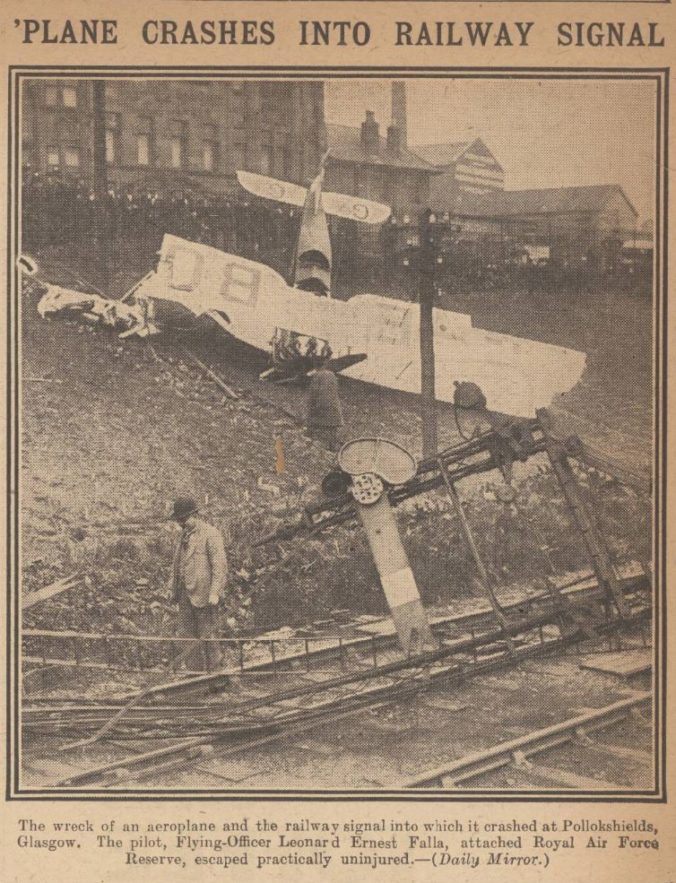
May 26, 2023 at 10:12 pm
What a corker of a story Andrew and certainly in the “why haven’t I heard of this before” category.
July 20, 2023 at 2:47 pm
Before and after WW2 my father worked in William Crockett & Sons ( Engineers) right beside Millar & Lang ( Printers) and directly across the road from where this aircraft landed and I remember him telling me that he came out of his work one day he saw a few ppl. over at the railings, who seemed to be looking down at the Railway lines. His curiosity got the better of him and he crossed over to have a look with the others and it turned out there was a long row of Railway carriages lined up behind a stopped steam Loco., not only that standing in an equally long line in front of the carriages were these Italian Prisoners of War in uniform. My father didn’t know why the loco. was stopped and why the Italian POWs were outside the carriages. On a lighter note…In the 1950s the famous Glasgow Rangers FC centre forward Billy Simpson had a lot of Greyhounds which he kept in kennels at that exact same spot on the Railway embankment.